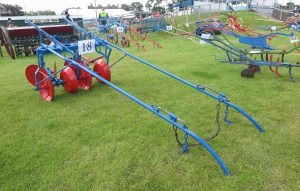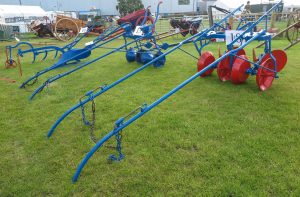The Scottish exhibitors at the Royal Show of the Royal Agricultural Society of England were always small in number, but included some of the major names. Indeed, attendance at the show says a lot about the stature and aspirations of these businesses. In 1912 when the show was at Doncaster a number of the Scottish makers attended to compete for the Society’s silver medals and to show their new innovations.
A short article published in The Scotsman of 2 July 1912 provides an illuminating account of the innovations that the Scottish makers were taking to the show as well as the names of the Scottish makers that attended:
“New Scottish implements
The display of implements presents the fullest degree that instructive variety which always characterises the Royal Showyard, and as an exposition of the mechanical aids to agriculture nothing better could be desired. The number of stands in this department is 442, the amount of shedding allotted being 13,538 feet, while there are numerous open-space exhibitors. Forty-seven machines and appliances of various sorts have been entered as “new implements” to compete for the Society’s silver medals. One of the new inventions comes from East Lothian, this being Mr David Wilson’s (East Linton) “Excelsior” potato raiser. This machine was exhibited at the Royal Highland Society’s trials, but while it was highly satisfactory in most respects, it could not work when the tops were there. To deal with the tops Mr Wilson has introduced cutters in each side of the drill, which it is claimed, will now overcome the difficulty experienced last season. The Agricultural Implement Company, Dundee, show two new implements. One is Mr W. M. Martin’s patent potato raiser. Manufactured in Perth, it consists of a revolving sieve containing internal worms, which take the earth containing the tubers from the adjustable share, and while conveying same backwards, riddle the potatoes from the soil, which are then delivered on the ground without being bruised or scattered. The other new implement by the same inventor is a haulm cutter for use when the haulm of potatoes require to be cut. It consists of revolving fan-like cutting blades, with guides for leading the haulms into the blades, and which throw aside the haulms when cut.
Among the other Scottish exhibitors who have stands are Messrs Kemp & Nicholson, Stirling; A. Jack & Sons, Maybole; J. Wallace & Sons, Glasgow; J. & R. Wallace, Castle Douglas; P. & R. Fleming, Glasgow; Marshall & Philp, Aberdeen; Barclay, Ross & Tough, Aberdeen; Carron Co., Stirlingshire; Alley & McLellan (Ltd), Glasgow; A. Pollock, Mauchline; George Sellar & Son, Huntly; W. Elder & Son (Ltd), Berwick: T. Hunter & Sons, Maybole; James Marshall, Aberdeen.”
How many of the names of the Scottish makers that attended do you recognise? Do you think they could be described as representing all that was great about agricultural implements and machines?


